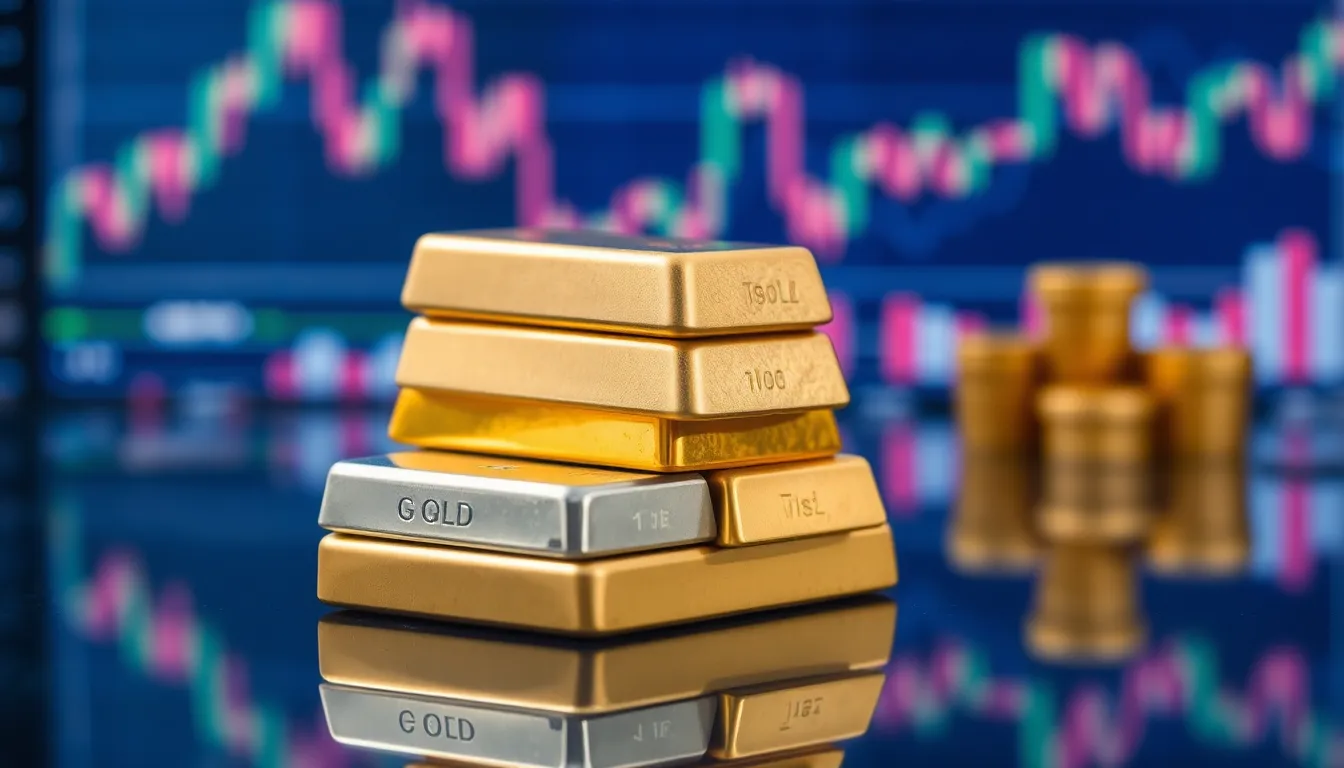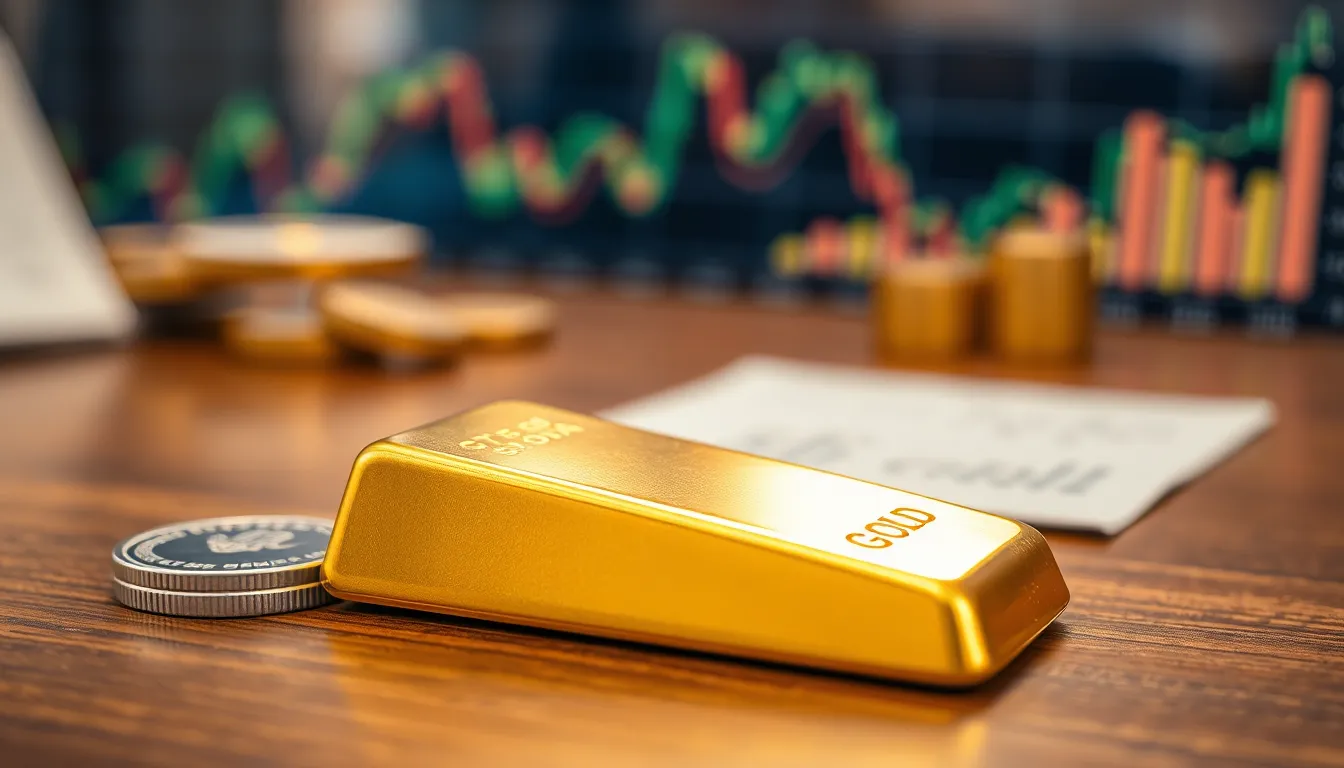In a world where every shiny object seems to catch the eye, gold and silver stand out as the ultimate bling. But what’s the deal with their spot prices? These numbers can make or break an investment, and they fluctuate more than a cat on a hot tin roof. Understanding spot prices isn’t just for treasure hunters; it’s essential for anyone looking to navigate the glittering but sometimes murky waters of precious metals.
Table of Contents
ToggleOverview of Spot Price on Gold and Silver
Spot price represents the current market price for immediate delivery of gold and silver. It fluctuates continuously due to market demand, geopolitical events, and economic indicators. Investors closely monitor these prices since they directly influence overall market trends.
Gold’s spot price typically serves as a benchmark for determining value in various applications, including jewelry and industrial uses. Silver often trails behind gold in price, making it a more accessible investment for many. Both metals are influenced by similar factors, including currency strength and inflation rates.
Market exchanges, such as the London Metal Exchange and the New York Mercantile Exchange, list spot prices for gold and silver. Traders and investors gauge these prices to make informed decisions. Prices can change drastically within a single day based on transactions and market sentiment.
The trading volume also affects spot price. Higher trading volumes tend to lead to increased price stability. Conversely, lower volumes can contribute to larger price swings. Adverse economic news often results in sudden spikes or drops in prices, highlighting the market’s responsiveness to external influences.
Keeping apprised of spot prices allows investors to seize opportunities for buying or selling. Historical price charts provide insight into past trends, helping investors predict future movements. Monitoring the spot prices of gold and silver remains essential for anyone looking to invest wisely in these precious metals.
Factors Influencing Spot Prices

Understanding the factors influencing spot prices is critical for investors in gold and silver. Numerous elements shape these prices and lead to fluctuations.
Economic Indicators
Economic indicators play a significant role in determining spot prices. Inflation rates directly impact the value of precious metals, as they often serve as a hedge against inflation. Interest rates also influence these prices; higher rates typically decrease investment in gold and silver, driving prices down. Gross Domestic Product (GDP) growth signals a strong economy, which can lead to diminished demand for safe-haven assets. Conversely, weaker economic data can boost interest in gold and silver, pushing prices higher. Each of these indicators creates a ripple effect in the market, affecting investment behavior and market sentiment.
Market Demand and Supply
Market demand and supply dynamics directly influence spot prices for gold and silver. High demand often drives prices upward, especially during periods of economic uncertainty or geopolitical tensions. Similarly, supply constraints can elevate prices. Factors like mining output, recycling rates, and inventory levels affect the available supply of these metals. Gold’s demand in jewelry manufacturing and silver’s utilization in electronics also sustain a vibrant market. Investors must monitor these changes regularly since shifts in demand and supply considerably impact spot prices. Awareness of such trends helps investors make informed decisions regarding their investments in precious metals.
Historical Trends in Spot Prices
Historical trends in spot prices for gold and silver reveal significant fluctuations driven by various economic factors. These trends provide insight into market behavior and investment strategies.
Gold Spot Price Trends
Gold’s spot price has experienced substantial variability over the past decades. In the 2000s, prices saw an upward trajectory, culminating around $1,900 per ounce in 2011, largely due to post-financial crisis demand for safe-haven assets. Notably, gold often responds positively to inflation concerns and geopolitical instability. Recent years have seen a retreat from those heights, with spot prices hovering between $1,600 and $1,800 due to recovering economies and shifting interest rates. Tracking these trends helps investors anticipate potential price movements as global events unfold.
Silver Spot Price Trends
Silver’s spot price trends exhibit different patterns compared to gold. Historically, prices for silver reached a peak near $50 per ounce in 1980 driven by speculative investment and soaring demand. Markets shifted in the subsequent decades, leading to more moderate fluctuations, often influenced by industrial usage and economic cycles. Currently, silver ranges between $20 and $30 per ounce, affected by factors such as currency strength and inflationary pressures. Monitoring these trends aids investors in making informed decisions about silver investments, given its dual role as both an industrial metal and a precious metal.
Current Market Analysis
Current trends in gold and silver spot prices reflect significant market movements influenced by various factors. Investors remain attentive to daily fluctuations, especially in light of geopolitical tensions and inflation concerns.
Recent Developments
Recent data indicates increased demand for gold as a safe haven asset. Spot prices fluctuated, reaching around $1,800 per ounce as of October 2023, driven by uncertainty in global markets. Silver’s spot price also showed resilience, sitting near $25 per ounce due to its industrial applications and investment interest. Analysts report that central bank policies play a vital role in shaping these trends, with increased purchasing by central banks recently amplifying gold’s appeal. Market sentiment remains volatile, with sharp price changes occurring based on economic reports and external factors.
Predictions for Future Prices
Market analysts predict gold’s spot price could breach the $2,000 per ounce mark by late 2024. Factors such as persistent inflation and rising geopolitical risks contribute to this forecast. Conversely, silver’s forecast suggests potential growth towards $30 per ounce, influenced by increased industrial demand and supply constraints. Both precious metals’ prices may experience volatility based on economic cycles and investor behavior. As long as economic uncertainties prevail, strong interest in both gold and silver is likely to continue. Monitoring these predictions offers valuable insights for investors looking to capitalize on market movements.
Investment Implications
Understanding investment implications related to gold and silver spot prices helps investors navigate market complexities. Spot prices influence investment decisions, indicating potential profit margins.
Strategies for Investors
Diversification enhances portfolio stability by including gold and silver. Investors often consider allocating a specific percentage to precious metals to hedge against economic uncertainty. Tracking spot price trends assists in determining optimal times for buying or selling. Establishing a target price facilitates concrete decision-making during volatile periods. Engaging with market news allows for adaptive strategies in response to global events. Utilizing various investment options, such as ETFs or physical bullion, can cater to differing risk tolerances.
Risks and Considerations
Market volatility poses significant risks for investors in gold and silver. Fluctuating spot prices can lead to unpredictable returns, so monitoring economic indicators is crucial. Political instability may disrupt supply chains, impacting availability and prices. Understanding liquidity is important; in low-volume environments, price swings tend to be more pronounced. Investing without thorough analysis may lead to missed opportunities, so thorough research is recommended. Staying informed about geopolitical dynamics enables investors to better assess risk exposure.
Understanding the spot prices of gold and silver is crucial for any investor looking to navigate the volatile precious metals market. These prices not only reflect current market conditions but also serve as indicators of broader economic trends. With ongoing geopolitical tensions and inflation concerns, staying informed about these fluctuations is essential for making sound investment decisions.
As the market evolves, the potential for significant price movements remains high. Investors should remain vigilant and consider diversifying their portfolios with gold and silver as a hedge against uncertainty. By tracking spot price trends and understanding the factors at play, they can better position themselves to capitalize on future opportunities in this dynamic market.





